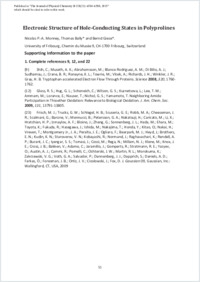Electronic structure of hole-conducting states in polyprolines
- Monney, Nicolas P.-A. University of Fribourg, Switzerland
- Bally, Thomas University of Fribourg, Switzerland
- Giese, Bernd University of Fribourg, Switzerland
-
04.06.2015
Published in:
- The Journal of Physical Chemistry B. - 2015, vol. 119, no. 22, p. 6584–6590
English
Electron transfer over long distances in proteins by a hopping process requires transient relay stations that can harbor charge and spin for a short time span. Certain easily oxidizable or reducible side chains may assume that role, but it has been shown that charge transport in peptides can also take place in the absence of such groups which implies that the peptide backbone provides for hopping stations. We have identified three different types of radical cation states in such peptides that are associated with significantly lower ionization potentials than those of the constituent amino acids, and which may thus serve as relay stations for hole transport. Which of these states is the most stable one depends on the nature and the conformation of the peptide. In contrast to α-helices which, due to their high dipole moments, can only form stable radical cation states that are localized on the C-terminal amino acids, polyprolines are capable of accommodating such states inside the PPII helices and those states may serve as relay stations for hole transfer through polyprolines. Of which type these states are depends often on small conformational changes, and sometimes the most stable states are hybrids of the three types we have identified.
- Faculty
- Faculté des sciences et de médecine
- Department
- Département de Chimie
- Language
-
- English
- Classification
- Physics
- License
- License undefined
- Identifiers
-
- RERO DOC 257123
- DOI 10.1021/acs.jpcb.5b02580
- Persistent URL
- https://folia.unifr.ch/unifr/documents/304463
Other files
Statistics
Document views: 68
File downloads:
- ball_esh.pdf: 158
- ball_esh_sm.pdf: 98

